-
Weekly weather: Strong cold air is expected to remain in the sky from now on. Be careful of the impact of snow on traffic during the year-end and New Year holidays
2025/12/29 08:24
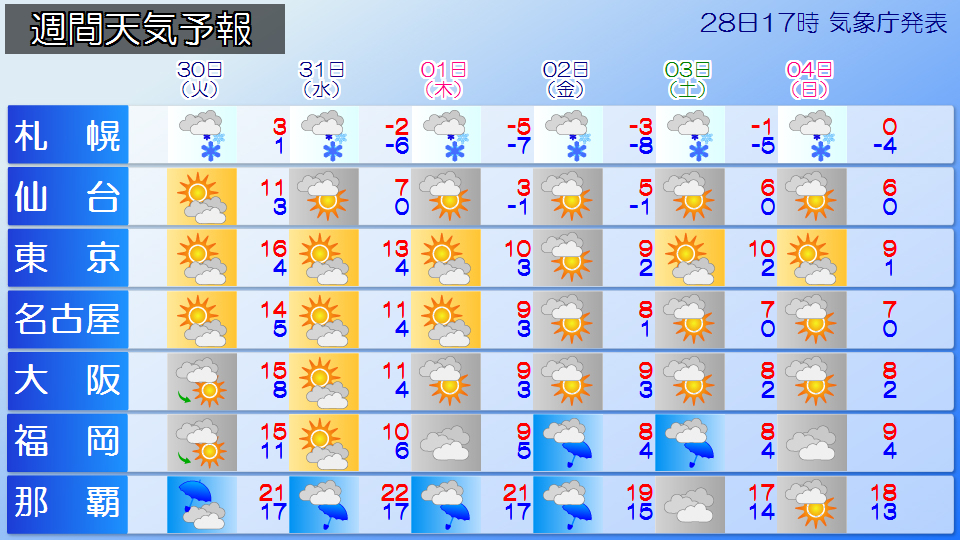
-
From now on, winter-like atmospheric pressure patterns are expected to continue around Honshu, and strong cold air will remain in the upper atmosphere. There will continue to be snowy days, especially from northern Japan to western Japan on the Sea of Japan side.
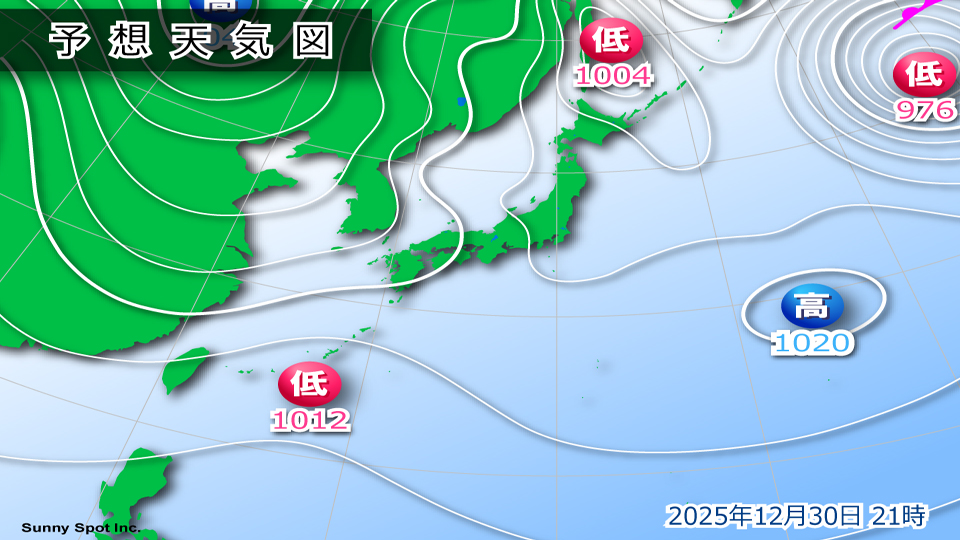
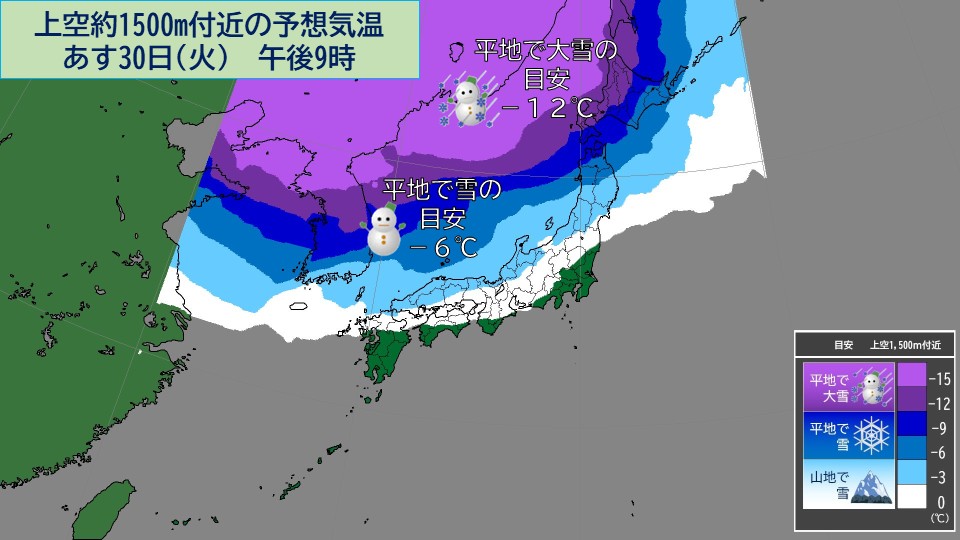
Tomorrow, the 30th (Tuesday), the area around Honshu will gradually become winter-like, with high pressure in the west and low pressure in the east. Looking at the forecast for cold air at an altitude of approximately 1,500 meters above the ground, it is predicted that strong cold air will move south toward the Sea of Japan region on the night of the 30th. In northern Japan, it is likely that snow will become heavier in some places from the night of the 30th tomorrow. On New Year's Eve, the 31st (Wednesday), snow is expected to spread from northern Japan to the Sea of Japan side of Hokuriku, with localized areas of heavy snowfall expected.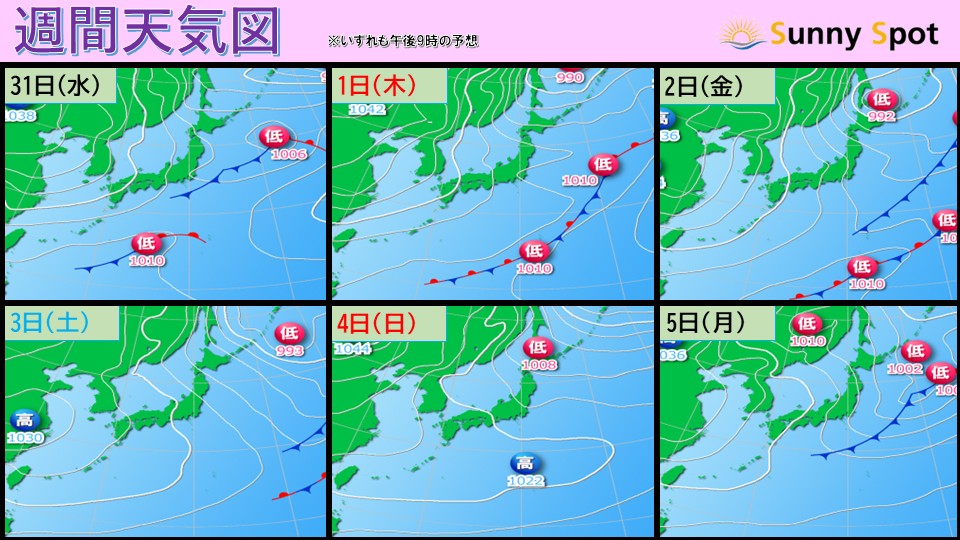
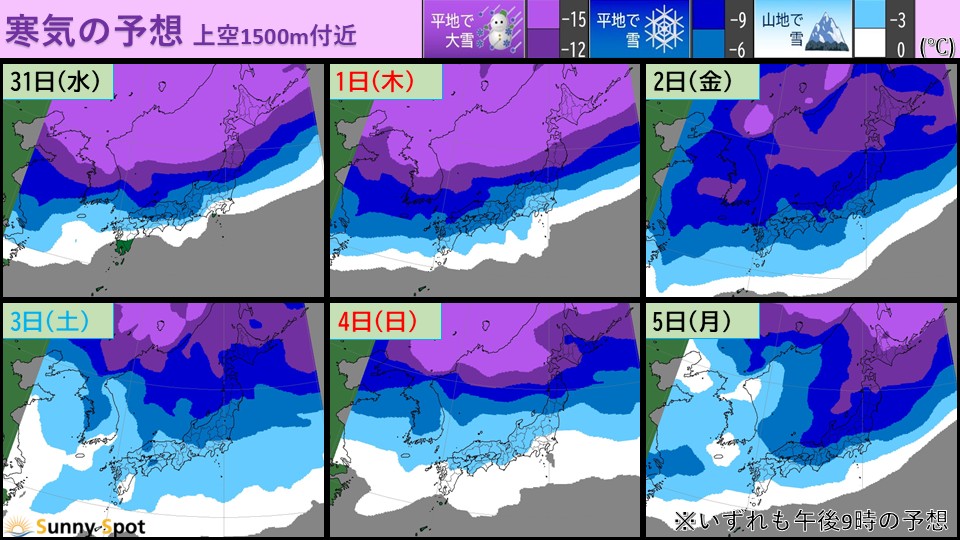
Looking at the forecast weather map after that, it is expected that the pressure pattern around Honshu will continue to be high in the west and low in the east from New Year's Eve on the 31st (Wednesday) until around the 5th when work begins. During this time, strong cold air will be present around 1,500 meters above Honshu, and snowy days will continue for a long time, mainly on the Sea of Japan side. Particularly in northern Japan, the cold air, which is a sign of heavy snowfall, will remain for a long time even in flat areas, so there is a risk of heavy snowfall and further increase in snowfall. Snow will also fall along the mountains of the Kanto-Koshin and Tokai regions, and it is likely that the snow will become heavier in some areas.
It is possible that the timing of the heavy snowfall coincides with the timing of returning home or U-turn rush. If you have plans to return home or travel during the New Year holidays, be sure to pay attention not only to the latest weather information, but also to check the latest traffic information frequently. Also, if you are driving, please be aware of the road conditions.
In case you get stranded, we recommend that you prepare as much as possible with warm clothing such as cold weather gear and blankets, water, emergency food, mobile batteries, and equipment such as shovels and boots for snow removal.

-
Today, the 29th (Sunday), a trough of atmospheric pressure approaches the Sea of ??Japan side; Northern Japan should be careful of avalanches and falling snow due to melting snow.
2025/12/29 07:03

-
Today, near Honshu, the high pressure system is gradually moving away to the eastern ocean, and the area on the Sea of Japan side is gradually approaching a trough of pressure. Rain clouds accompanied the trough in the atmospheric pressure near the Izu Islands and the Nansei Islands, and in some places in the Sakishima Islands, heavy rain was observed in the early morning hours.
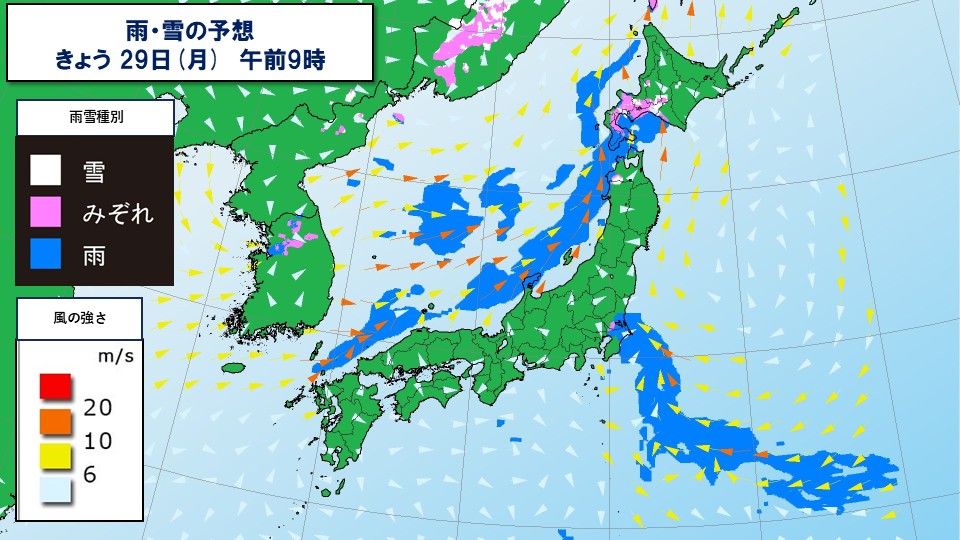
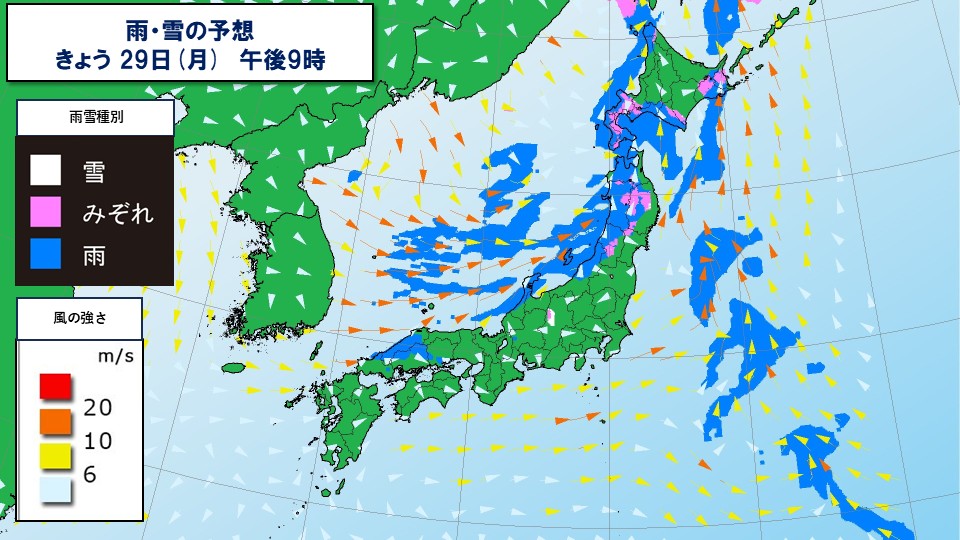
As the atmospheric pressure trough approaches, cold air will move northward, resulting in rain instead of snow in many places in northern Japan. It looks like there will be some places along the mountains where it will snow. In areas with heavy snowfall, the snow may melt and road conditions may deteriorate. Please be careful of snow falling from the roof and avalanches.
In the coastal areas of the Kanto region, due to the influence of the atmospheric pressure trough, it will rain mainly in the morning, and in some parts of Chiba Prefecture there will be snow. However, the rain and snow will only last for a short time, and in many places the weather will improve by the afternoon.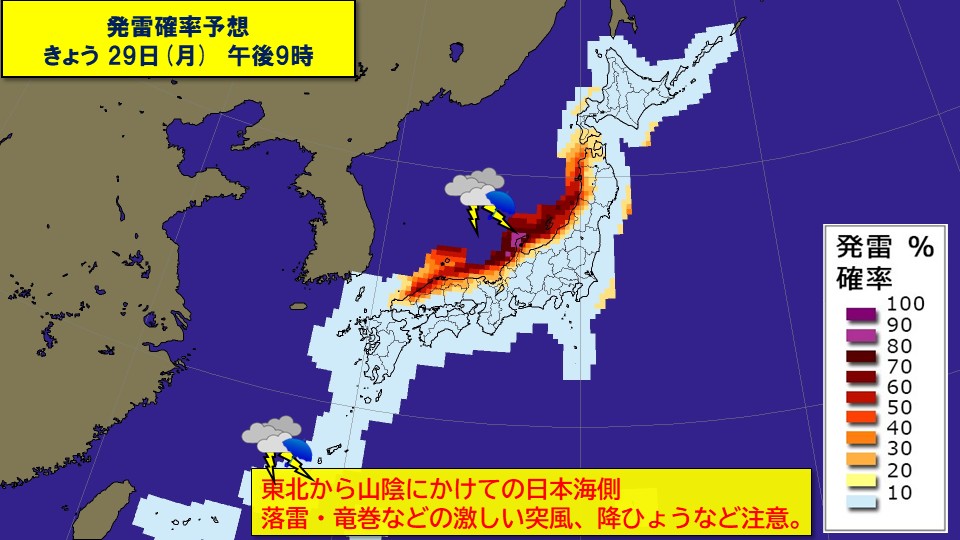
Clouds will gradually spread over Hokuriku, San'in, and northern Kyushu, and there will be places with rain and thunderstorms. Atmospheric conditions will become unstable, especially in the coastal areas of Hokuriku, making it easier for thunderclouds to develop. Please be careful of lightning, tornadoes, gusts of wind, hail, etc.
Okinawa will be covered in persistent rain clouds, and it will rain on and off. It is likely that there will be heavy rain with localized thunderstorms. Please be careful about how it rains.
It is expected to be sunny in many places on the Pacific side west of the Tokai Sea. Temperatures are expected to be higher than yesterday (Saturday, the 28th) in many places, with some places in western Japan expected to reach around 15 degrees Celsius during the day. In sunny areas, the air is dry, so please be careful when handling sources of fire.
-
[New Year's Cold Wave] Where can you see the first sunrise of the year There is a risk of stormy weather due to U-turn rush
2025/12/28 14:24
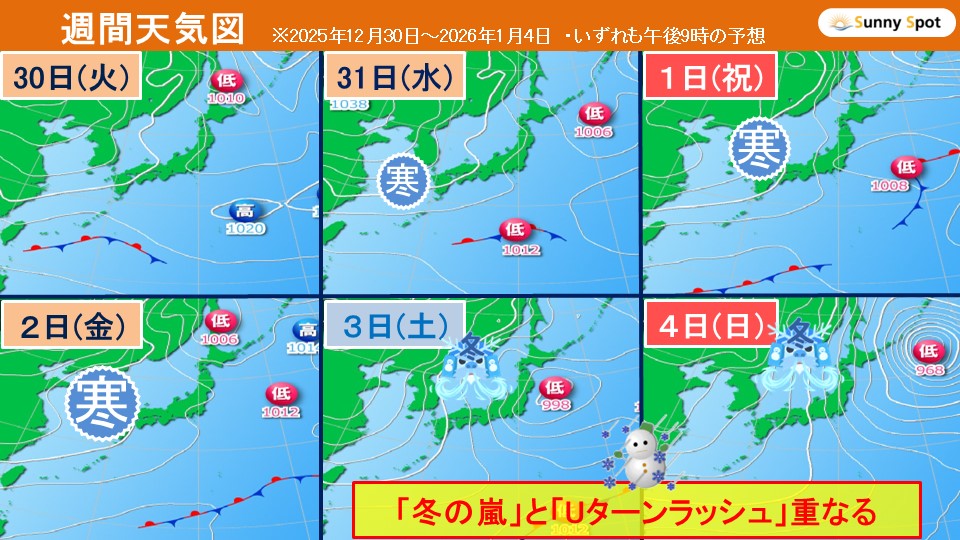
-
#Weather tips for the year-end and New Year holidays#
+New Year's Eve~ Cold wave hits, heavy snow and blizzard on the Sea of Japan side
+First sunrise, better chance to see it on the Pacific side
+Around January 3rd to 4th: ``Winter storm'' on the Pacific side as well with snow
+U-turn rush: Stronger snow and wind, affecting transportation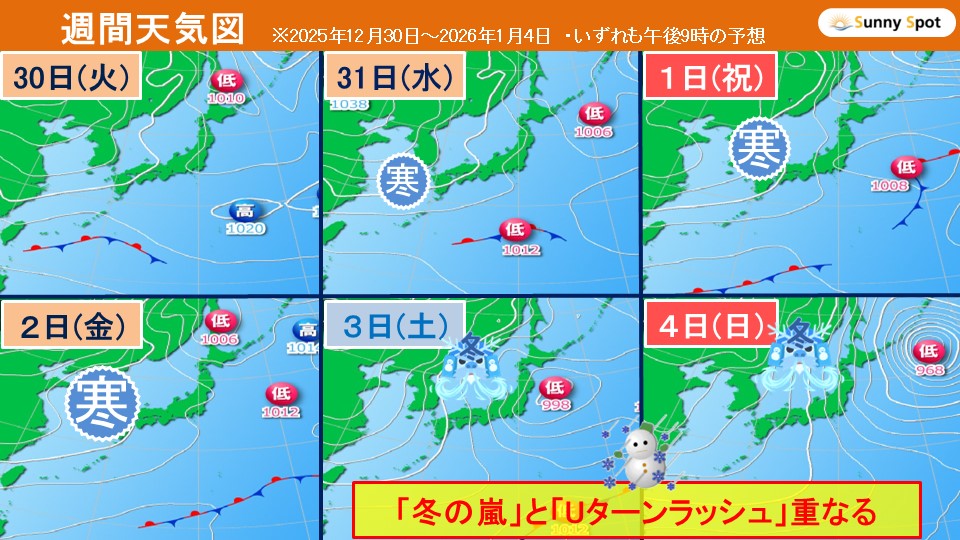
Today, December 28th (Sunday), the area around Japan is covered by a mobile high pressure system, and
the winter-like pressure pattern that has continued in northern Japan is loosening.
Although the area of snow falling on the Japan Sea side of northern Japan is becoming narrower,
road conditions will continue to be poor due to the snow that has fallen so far, so please continue to use caution when driving.
#Tomorrow 29th (Monday) - 30th (Tuesday)#
A low pressure system is approaching Hokkaido, and a front (pressure trough) extending from the low pressure system is expected to pass near Honshu.
In the afternoon of tomorrow, the 29th (Monday), rain and snow will fall from the San'in area to the Sea of Japan side of Hokkaido.
Snow and rain are expected to continue on the Sea of Japan side of Tohoku and Hokuriku until the 30th (Tuesday).
On the other hand, many places on the Pacific side are covered by high pressure, and the winter weather is likely to continue.
As the air continues to dry, please be careful when handling fire.
#31st (Wednesday) New Year's Eve#
The area around Japan is expected to have a winter-like atmospheric pressure pattern of high in the west and low in the east.
Gradually, strong cold air will begin to flow into the sky, and a "New Year's cold wave" will arrive.
Snow and rain continue on the Sea of Japan side and Hokuriku in northern Japan,
winds are also increasing, and there are likely to be snowstorms in some places in northern Japan.
Please be careful of poor visibility when driving.
#January 1, 2026 (holiday), New Year's Day#
On New Year's Day, the winter-like air pressure pattern will continue, just as it did on New Year's Eve, and cold air will remain in the sky above
.
Snow and rain are expected to continue on the Sea of Japan side of northern Japan and Hokuriku.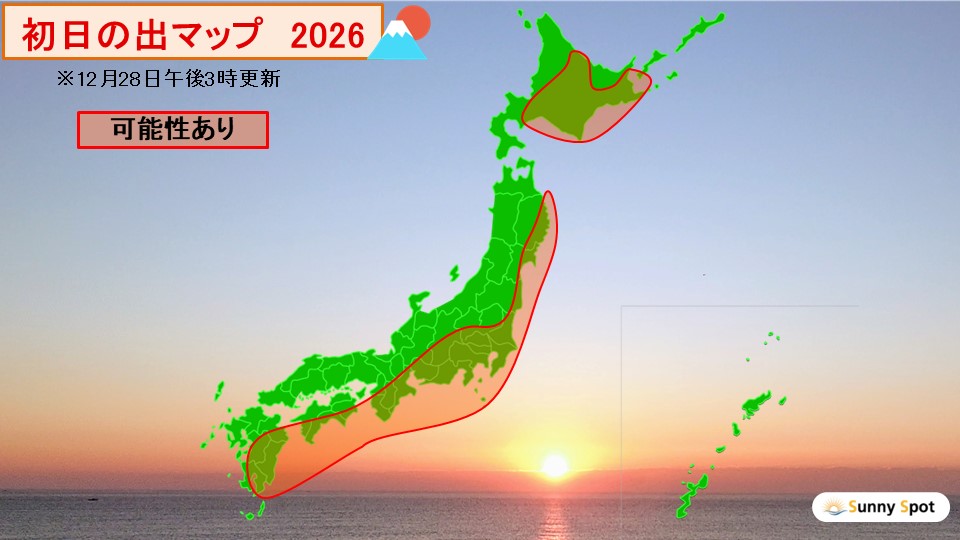
At the time of the first sunrise, the Pacific side of northern and western Japan will be clear, and it seems that there will be many places where the first sunrise can be seen, mainly on the
Pacific side.
The Sea of Japan side is covered with snow and rain clouds, and there are likely to be fewer places where you can see the first sunrise of the year.
#2nd (Friday)#
Although a high pressure system is protruding from the continent, snow and rain are expected to continue on the Sea of Japan side due to the strong cold air above
.
In addition, there is a possibility that the JPCZ (Japan Sea Polar Air Mass Convergence Zone) will be directed towards the San'in region, northern Kinki region, and Hokuriku region.
On the Sea of Japan side, snow continues to fall in the same places for a long time,
It seems that there will be places where the snowfall will increase all at once.
Meanwhile, winter skies will continue on the Pacific side of western and eastern Japan.
#3rd (Sat)#
On the third day of the year, the winter-like atmospheric pressure distribution will become stronger,
more cold air will flow in than during the year-end and New Year holidays, and the Winter Shogun is likely to start in earnest.
Heavy snow and blizzard will occur mainly on the Sea of Japan side,
There will also be places on the Pacific side of the Pacific Ocean such as Kyushu, Shikoku, Kinki, and Tokai.
There is a possibility that it will snow even on the Pacific side, where it doesn't usually snow, so it is thought that
car slip accidents will be more likely to occur.
When driving, please be careful of traffic obstacles such as frozen roads.
#4th (Sunday)#
The Winter General is here to stay, and the strong winter-like atmospheric pressure pattern is expected to continue.
The rough weather with heavy snow and blizzards will continue mainly on the Sea of Japan side, and snow and rain is also expected on the Pacific side.
Even if it's sunny, the north wind will blow quite strongly and it will be bitterly cold.
Around 3rd to 4th of the new year, there will be a "U-turn rush" for people returning from their hometowns.
U Turn rush and stormy weather may overlap, so
Please continue to pay attention to the latest weather and traffic information.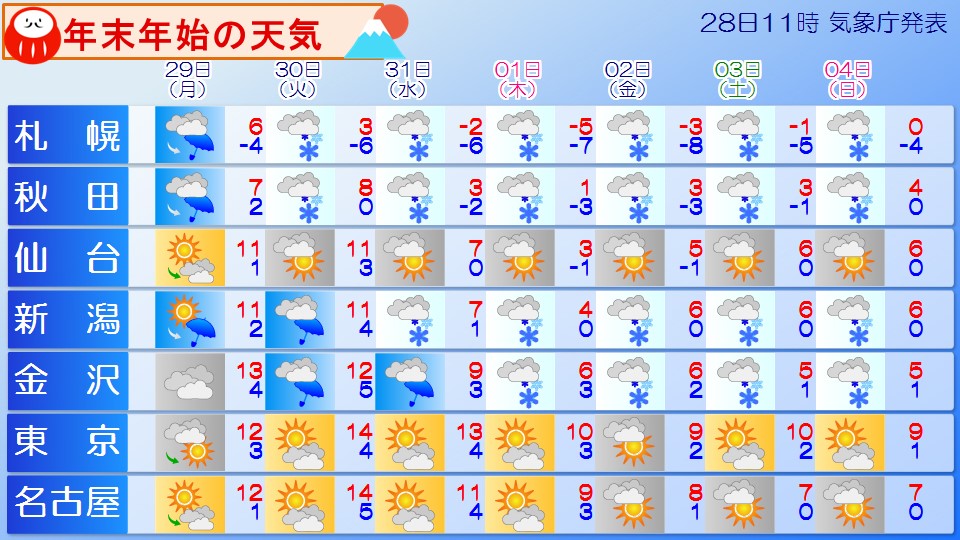
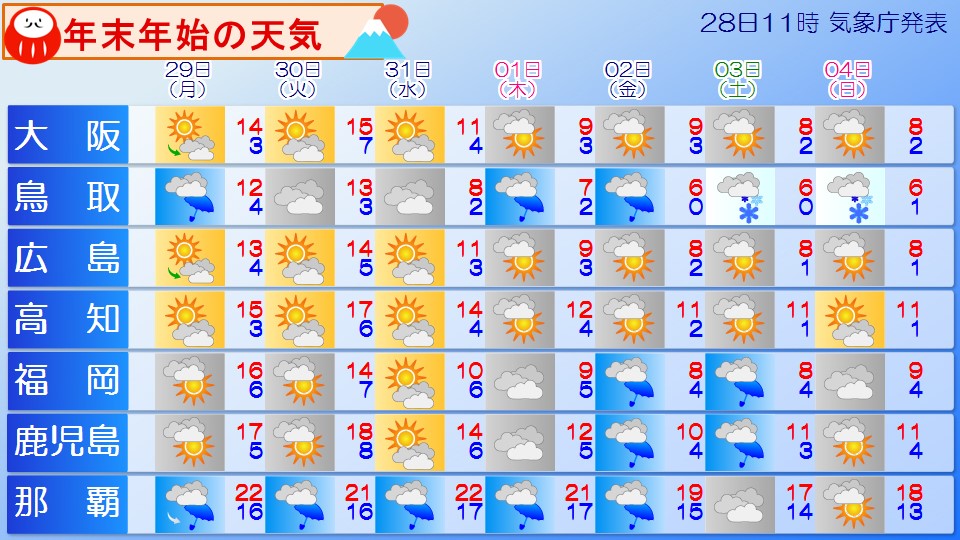
-
Tokyo falls below freezing for the first time this season, with temperatures rising in various places during the day compared to the previous day
2025/12/28 06:59
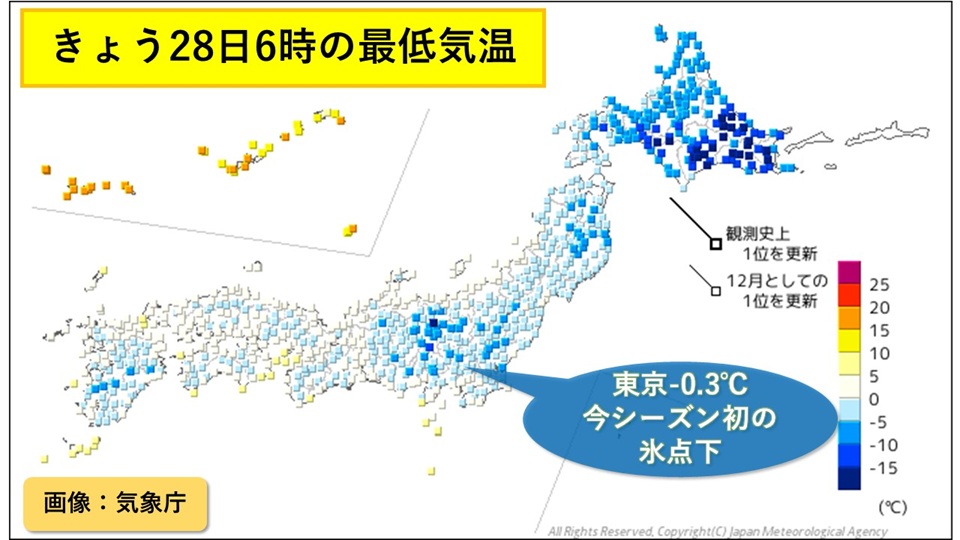
-
Kesa is becoming increasingly cold in various places due to the effects of cold air in the upper atmosphere and radiation cooling. In central Tokyo, the temperature was recorded at -0.3c at 05:40, the first sub-zero temperature of the season, making it extremely cold.
During the day, the area around Honshu will be covered in high pressure, and the cold air in the upper atmosphere will recede. Compared to yesterday (27th), the temperature is rising in many places, and the cold seems to be a little less severe.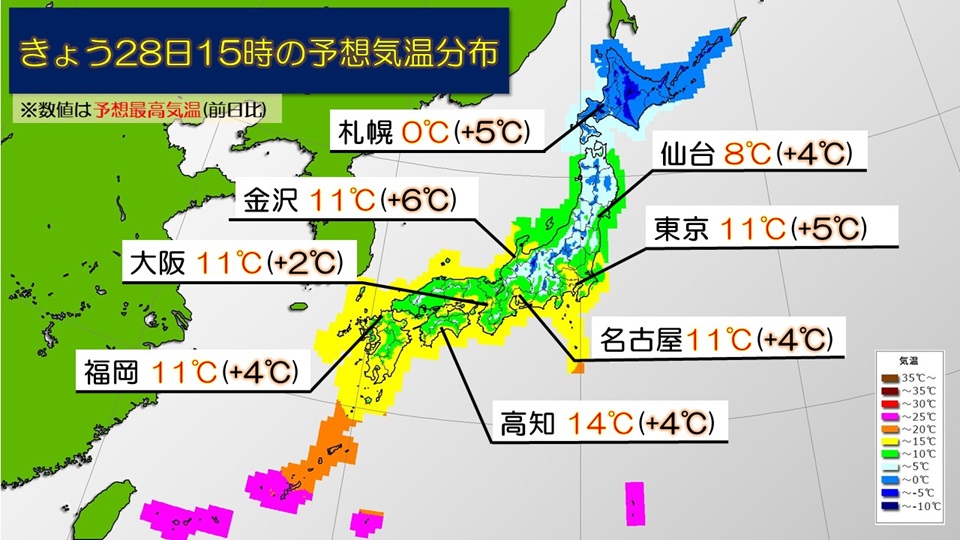
The predicted maximum temperature is Sapporo 0c, Sendai 8c, Tokyo 11c, Nagoya 11c, Kanazawa 11c, Osaka 11c, Kochi 14c, and Fukuoka 11c.
The temperature will be typical for this time of year in various parts of Japan, and in eastern and western Japan, the wind will be weak and it will feel warm under the sunshine.
The weather will be perfect for cleaning, so the work will be done quickly.
Please take care of your health as there is a large difference in temperature between morning and evening and during the day.
-
Weather for today, the 28th (Sunday): The weather is improving on the Sea of ??Japan side, and the Pacific side is also calm and sunny.
2025/12/28 06:28
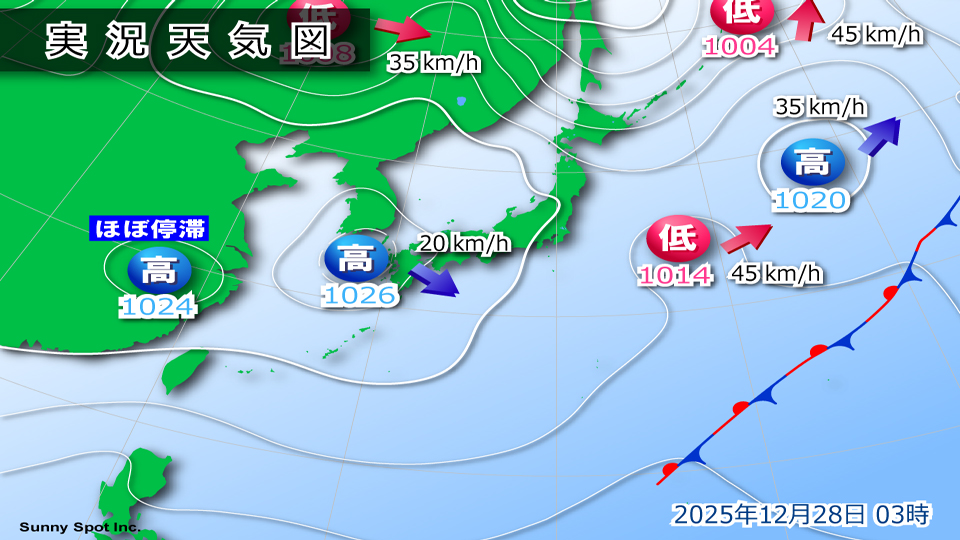
-
Today, the 28th (Sunday), a migratory high pressure system will move near Honshu, and the weather on the Sea of Japan side will also start to improve. It is expected to be sunny in many places on the Pacific side.
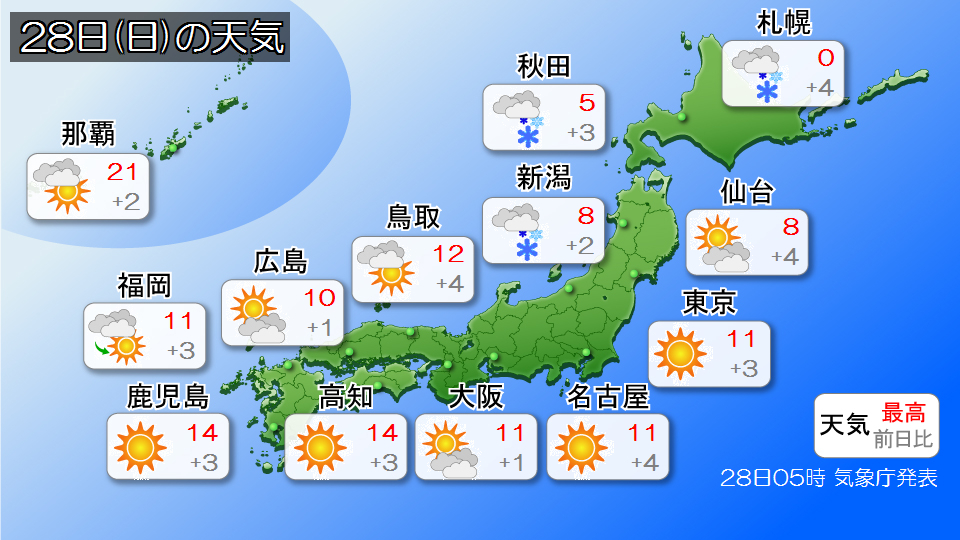
The Japan Sea side of northern Japan and Hokuriku will experience snow and rain mainly in the morning. In Hokkaido, there are places in northern Hokkaido where snowstorms occur, so be careful of poor visibility. The weather is expected to improve in many places in the afternoon.
There is also a possibility of showers and snow in the morning on the Pacific side of northern Japan. Please pay attention to changes in the sky.
Eastern and western Japan will have sunny skies in many places, especially on the Pacific side. The weather will be mild and sunny during the day, and it looks like the cleaning will be in full swing.
The sky in Okinawa is probably not clear due to the humid air. Even if there is time for sunshine, there is a chance of rain showers, so be careful.
-
[New Year's weather] New Year's Eve to New Year's Day: Winter-like atmospheric pressure distribution again, affecting transportation
2025/12/27 13:25
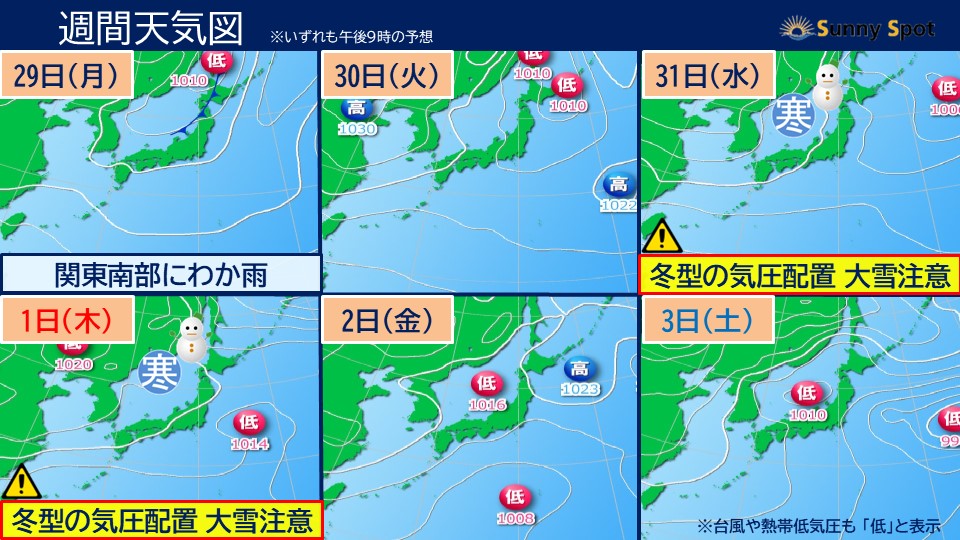
-
[Weekly Weather Forecast]
#Rain and snow on the Sea of Japan side Cleaning should be planned based on the weekly weather
#New Year's Eve to New Year's Day: Winter-like air pressure distribution again, impacting transportation
#Big daily temperature differences; new year will start at low temperatures mainly in northern Japan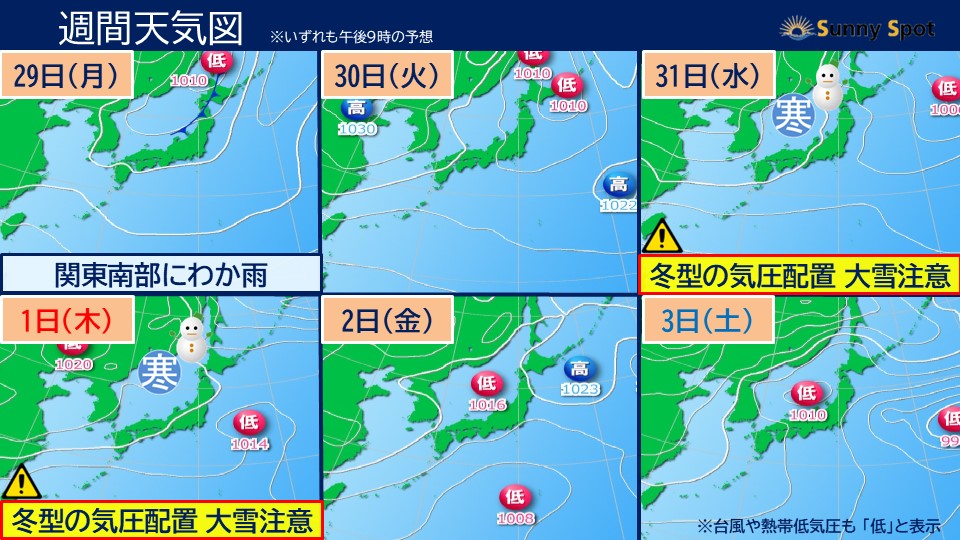
#Rain and snow on the Sea of Japan side Cleaning will be planned based on the weekly weather
Tomorrow, the 28th (Sun), a high pressure system will move near Japan, and the winter-like pressure distribution will gradually loosen.
Rain and snow in the San'in region and northern Kinki region are expected to stop in the afternoon, and snow and rain in Hokuriku and the Sea of Japan side of Hokkaido are expected to stop in the evening in an increasing number of places.
It will be mildly sunny elsewhere.
The next day, on the 29th (Monday), a high pressure system will move from Kyushu to the south of Japan, and Okinawa is expected to experience rain in some places due to the influence of moist air circulating around the edge of the high pressure system.
Please be careful of localized heavy rain, lightning, and gusts of wind.
Although it will be sunny in many places on the Pacific side, there will be clouds and showers in the southern Kanto region.
It is expected to rain in the afternoon on the Sea of Japan side of the San'in and Hokuriku regions, and there will be some snow in northern Japan.
On the 30th (Tuesday), there will be some rain in the Nansei Islands due to the influence of a low pressure system.
In addition, another low pressure system is expected to move towards Sakhalin, and a front is expected to pass near northern Japan.
It will rain in Hokuriku and the Sea of Japan side of Tohoku, and in Hokkaido it will turn to snow in more places from the north, and the rain will be heavier near the front.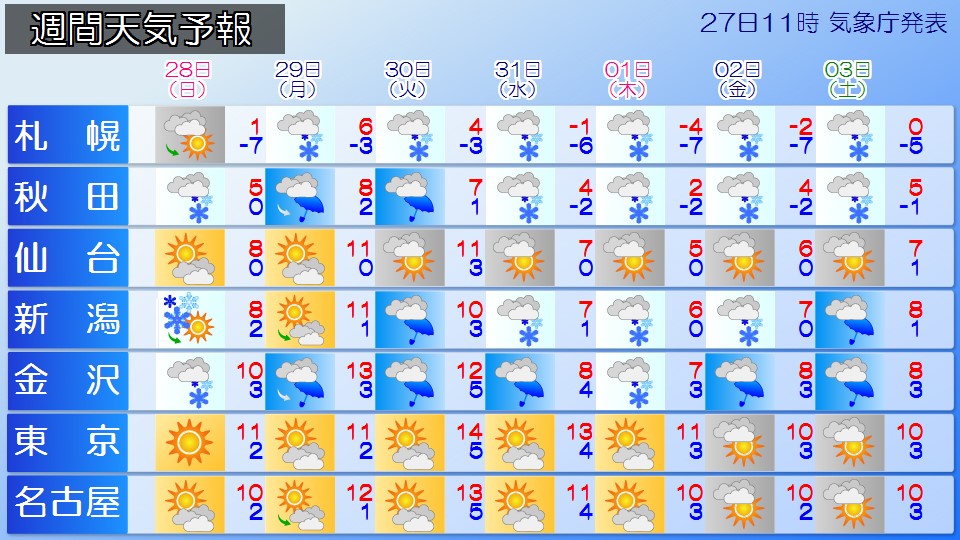
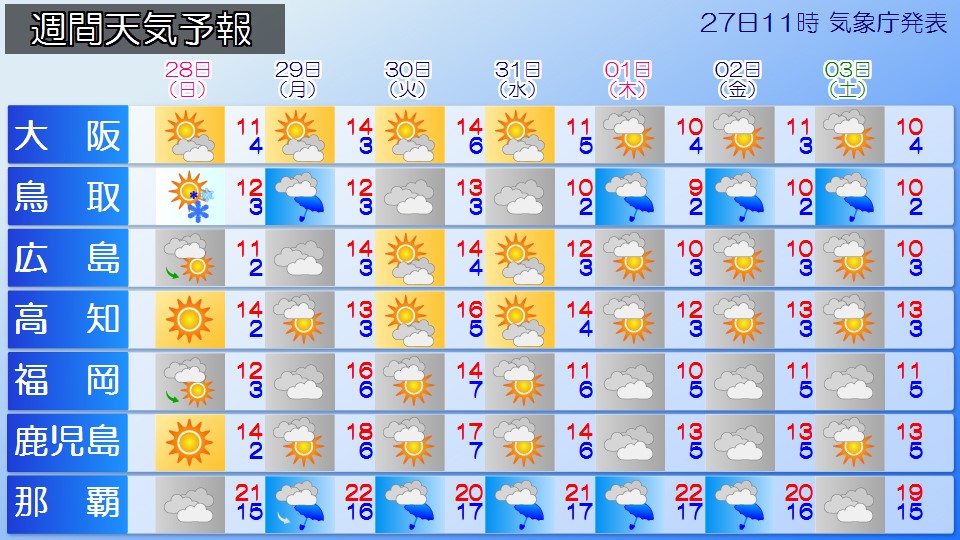
#New Year's Eve to New Year's Day: Winter-like pressure distribution again, affecting transportation
From New Year's Eve, Wednesday, January 31st to New Year's Day, January 1st, the low pressure system is expected to advance toward the Sea of Okhotsk, causing the continental high pressure system to overhang, resulting in a winter-like pressure system around Japan.
On New Year's Eve, Wednesday the 31st, there will be rain and snow in Hokuriku, and snow on the Sea of Japan side of northern Japan.On New Year's Day, Thursday, January 1st, there will be rain and snow in the San'in region and northern Kinki region, and there will be snow in places between Hokuriku and the Sea of Japan side of northern Japan.
Due to the strong cold air, heavy snow and strong winds are expected, especially on the Sea of Japan side of northern Japan.
Transportation facilities will be affected in some places.
When returning home or traveling on unfamiliar roads, be careful of deteriorating road conditions due to snow or ice.
On the other hand, there are many places on the Pacific side of western and eastern Japan that are sunny, and it is likely that you will be able to see the first sunrise on January 1st (Thursday), New Year's Day.
#Big daily temperature differences The new year will start with low temperatures mainly in northern Japan
The next day, from around the 29th (Monday) to the 30th (Tuesday), cold air will temporarily move north, and temperatures will be high for this time of year.
In snowy areas, be careful of changes in road conditions due to melting snow and falling snow.
After that, towards the beginning of the year, the number of places will be near normal, and temperatures will be lower than normal mainly in northern Japan, and the severe cold will return once again.
The more northerly you go in Japan, the greater the difference in temperature from day to day, so please take care of your health so that you don't get sick.
-
Storm and snow warnings, heavy snow warnings, and wave warnings have been announced. What is the outlook for the stormy weather
2025/12/26 13:30
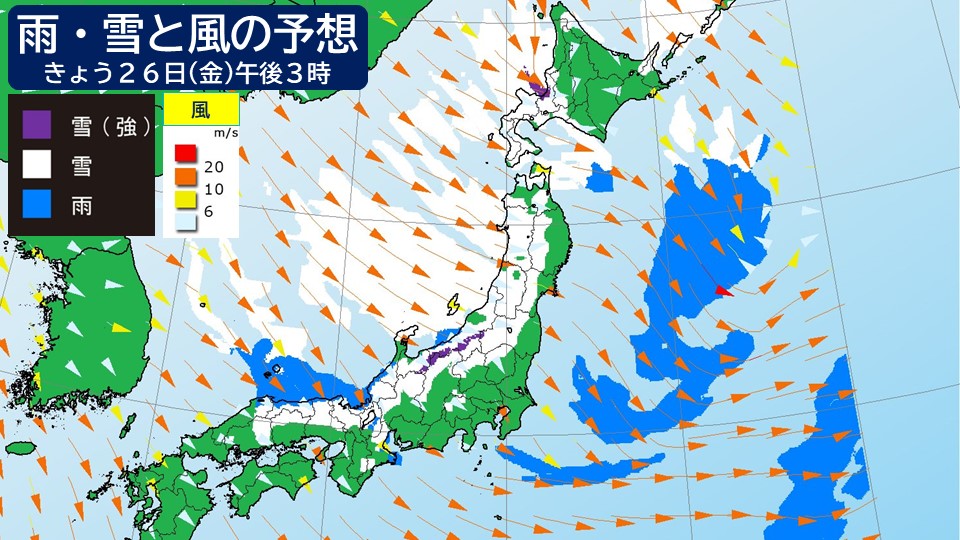
-
Today, the 26th (Friday), a low pressure system is developing near the Chishima Islands and moving north, creating a strong winter-like pressure pattern near Japan.
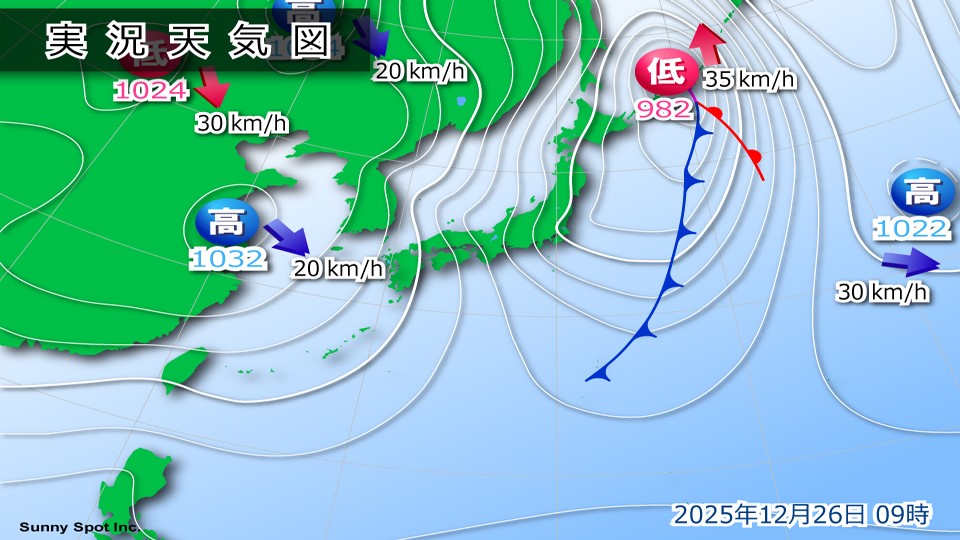
A strong cold air for this time of year, below -9c at an altitude of about 1500m, is flowing not only over eastern and northern Japan but also over western Japan.
The JPCZ (Japan Sea Polar Air Mass Convergence Zone) is formed in the western part of the Japan Sea, and is oriented towards the Japan Sea side from China to the Kinki region.
Heavy snow fell mainly on the Sea of Japan side, and the daily maximum 12-hour snowfall was 48 cm in Otari in Otari Village, Nagano Prefecture, 41 cm in Daisen in Daisen Town, Tottori Prefecture, and 38 cm in Uwano Kogen in Kami Town, Hyogo Prefecture. Over 30 cm of snow fell in just half a day, and snowfall is rapidly increasing.
In addition, the atmospheric pressure gradient was large, and stormy winds were blowing mainly on the Sea of Japan side, with a maximum instantaneous wind speed of 33.2 m/s observed at Hazaki in Sado City, Niigata Prefecture, at 3:56 a.m.
There are some places where there are heavy storms and severe storms.
As of noon, there are blizzard warnings in Tohoku and Hokkaido on the Japan Sea side, heavy snow warnings in northern Nagano Prefecture, and wave warnings in San'in and Tohoku on the Japan Sea side.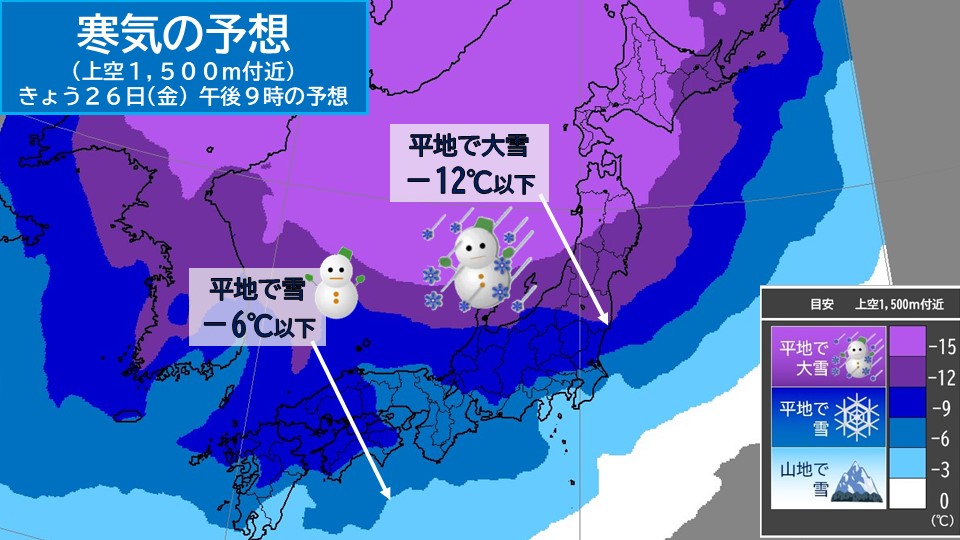
After this, the snow will become stronger and snowfall will increase in northern Japan, where the center of the cold air in the upper atmosphere will pass through.
The strong winter pressure pattern will gradually loosen from the west, but there are expected to be some places in northern Japan where extremely strong winds will blow until tomorrow, Saturday the 27th.
In western and eastern Japan today, the 26th (Friday), and in northern Japan through tomorrow 27th (Saturday), extremely strong winds accompanied by snow will blow mainly along the Sea of Japan, causing blizzards and blizzards in some places.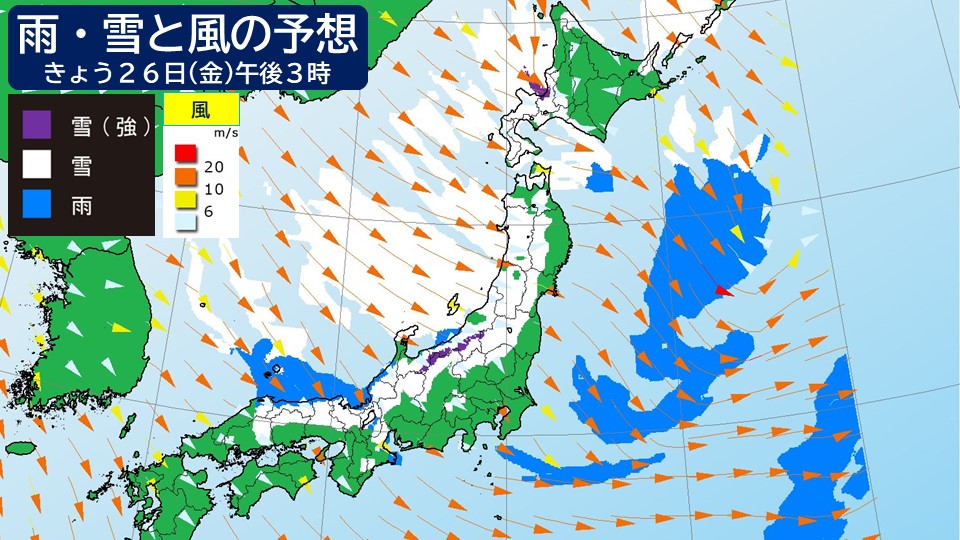
#Western Japan
+Kyushu
In northern Kyushu, the effects of the cold air have gradually weakened and there is no longer any threat of heavy snow, but there are places where snow has piled up, especially in the mountains, so please continue to be aware of traffic disruptions due to snow accumulation and frozen roads.
+China
It will snow heavily into the late evening of today, the 26th (Friday).
Also, the sea in the San'in area is expected to become swell and swell into the evening of today, the 26th (Friday).
+Kinki
The sea in the northern Kinki region will continue to be in rough conditions until the evening of today, the 26th (Friday), so please be careful of high waves.
Although the possibility of warning-level heavy snowfall has decreased in the northern and central Kinki regions, please be aware of traffic disruptions due to snow accumulation and frozen roads late into the evening of Friday, the 26th.
#Eastern Japan
+Kanto-Koshin
In Nagano Prefecture and the northern Kanto region, please be on guard for traffic disruptions due to snowfall and frozen roads through early evening Friday, the 26th.
+Hokuriku
The sea is expected to become rocky into the early hours of tomorrow, Saturday the 27th, with warning-level high waves.
#Northern Japan
+Tohoku
Beware of heavy snowfall from the afternoon of today, the 26th (Friday) to the early afternoon of the 27th (Saturday) tomorrow, and a blizzard from the west into the late evening of today, the 26th (Friday).
At sea on the Sea of Japan side of Tohoku, vigilance is required for high waves until late at night today, Friday the 26th.
+Hokkaido
On the Sea of Japan side, please be on guard for traffic disruptions due to heavy blizzard and snowdrifts from the evening of today, the 26th (Friday) to the evening of tomorrow, the 27th (Saturday).
Please be careful of traffic disruptions due to heavy snow from the afternoon of today, the 26th (Friday) to the morning of tomorrow, the 27th (Saturday).
-
1-month forecast: Severe cold mainly in western Japan; watch out for heavy snow early in the year on the Sea of Japan side
2025/12/26 08:10
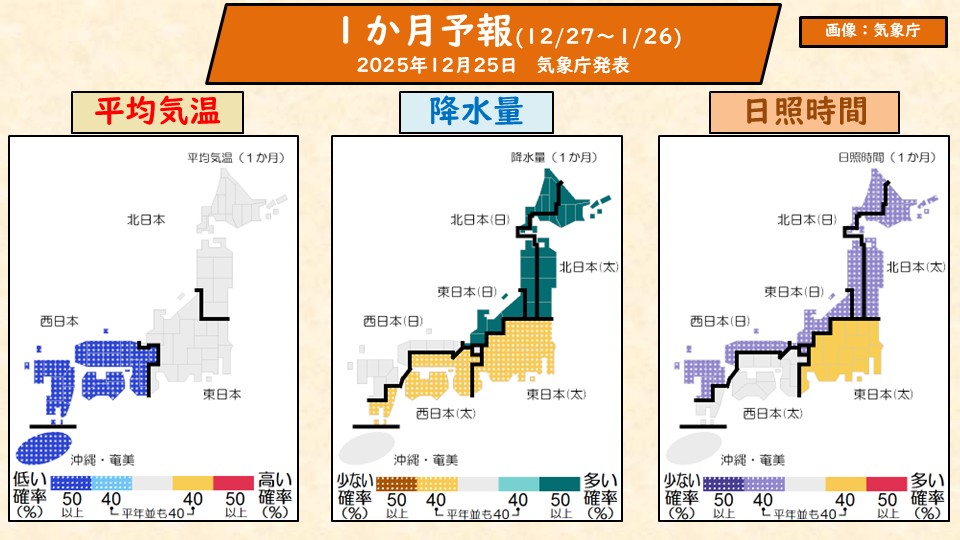
-
On the 25th (Thursday), the Japan Meteorological Agency announced the latest one-month forecast, which provides the weather outlook for the next month.
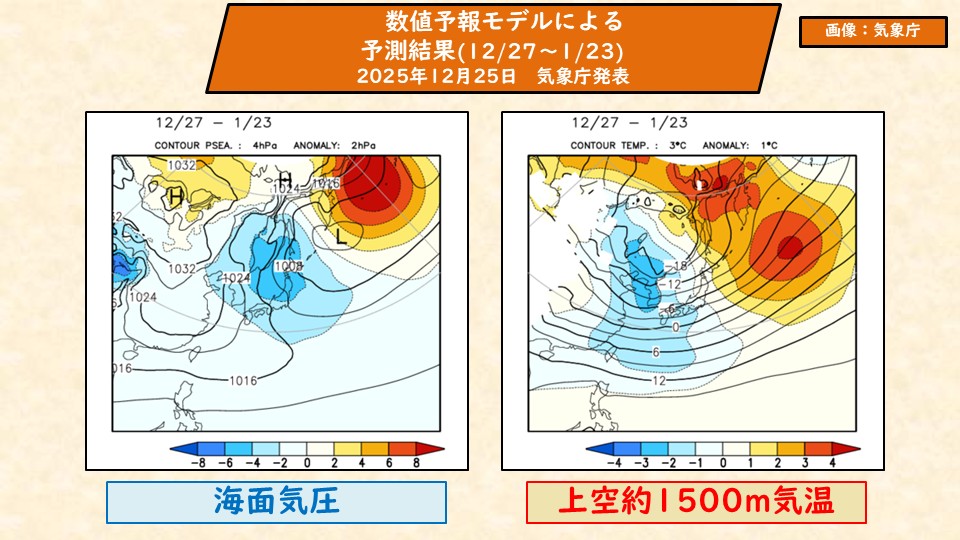
According to the numerical forecast, the monthly average sea level pressure will be lower than normal in northern Japan, and northern Japan will be susceptible to the effects of low pressure.
In eastern and western Japan, there is a large gradient in the east-west atmospheric pressure, so there will likely be periods when the winter-like atmospheric pressure pattern becomes stronger.
The temperature at around 1,500 meters above the ground is expected to be lower than normal, mainly in western Japan, Okinawa, and Amami, as there are periods when strong cold air moves southward.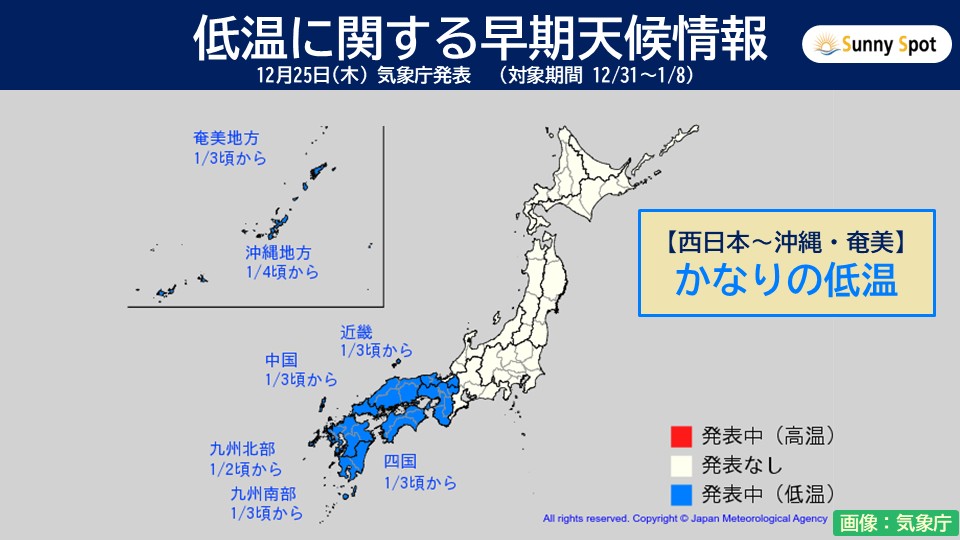
Also, on the same day, the 25th (Thursday), the Japan Meteorological Agency announced early weather information regarding heavy snow and low temperatures. From the beginning of the year, it is expected that western Japan will be more susceptible to the effects of cold air.
In western Japan, Okinawa and Amami, there is a possibility that the region will experience "once-in-a-decade" low temperatures due to strong cold air flowing into the region. Care must be taken when water pipes freeze and crops are managed.
In addition, the strong cold air will mainly affect the Sea of Japan region from Tohoku to the San'in area, and there is a risk that snowfall will be significantly higher than normal. According to the ``early weather information regarding heavy snowfall'' released by the Japan Meteorological Agency, starting around January 3rd or 4th of next year, the amount of snowfall is expected to be approximately 2 to 3 times the normal level for 5 days on the Sea of Japan coast from Tohoku to the San'in area. There is a possibility of heavy snow during the U-turn rush at the beginning of the year, so please be sure to check the latest weather and traffic information.
The Pacific coast west of the Kanto region will have many sunny days, and precipitation will be at or below normal.
-
Tomorrow, the 26th (Friday), there is a warning of heavy snow and blizzard, mainly on the Sea of Japan side; there is a risk of more than 50 centimeters of snow in many places.
2025/12/25 21:17
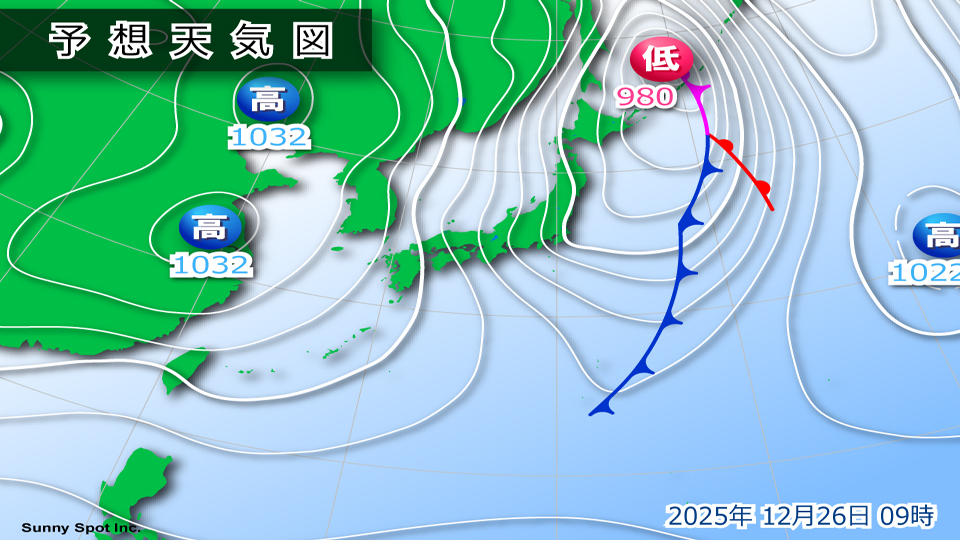
-
Tomorrow, on the 26th, the area around Honshu will have a strong winter-like atmospheric pressure pattern with highs in the west and lows in the east, with extremely cold air in the sky. Near Honshu, the isobar lines are vertically narrow, and winds blow strongly from the north. There is a risk of heavy snow and blizzard widespread from the Sea of Japan side of northern Japan to the Sanin area.
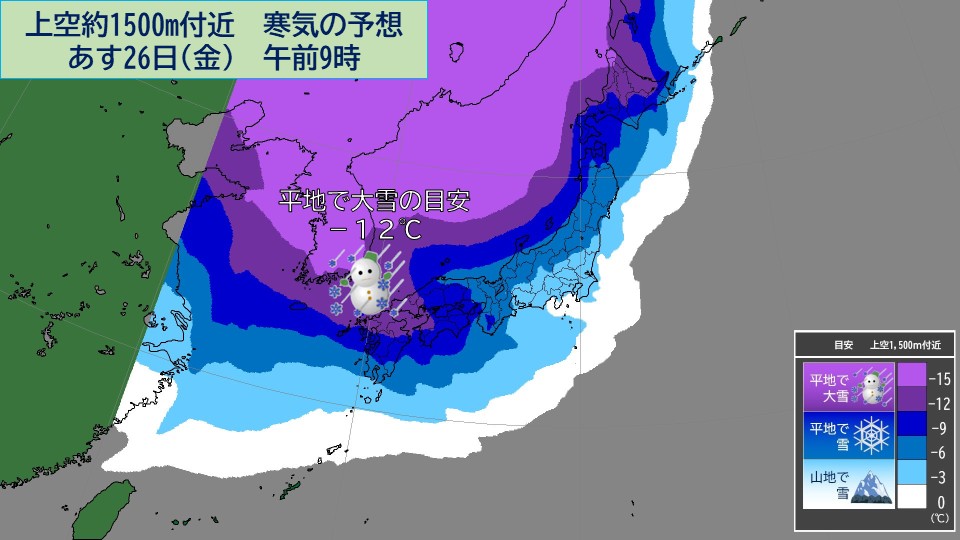
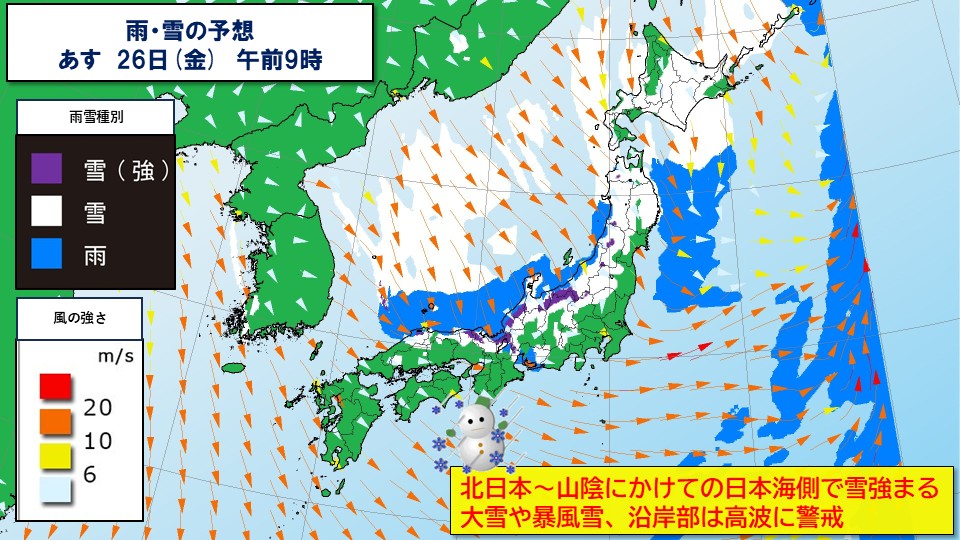
Tomorrow, the 26th (Friday), snow clouds will roll in one after another, especially along the Sea of Japan coast from Hokuriku to northern Kinki and the San'in region, and there is a risk that 24-hour snowfall could reach 50 to 60 cm in many places, especially along the mountains. There will be snowfall even in flat areas, and there will be areas where snowfall will increase rapidly in a short period of time. Snow will fall on the flatlands of northern Kyushu, and there are likely to be some places along the mountains of Tokai and Shikoku where it will snow into the morning.
Also, northerly winds will become stronger, mainly in areas along the Sea of Japan from Hokkaido to the Sanin area, causing blizzards in some places. In the coastal areas from Tohoku to the San'in area, waves are expected to rise and cause heavy swells.
From tomorrow the 26th (Friday) to the 27th (Saturday) the day after, please be on guard for rapid increases in snowfall due to heavy snowfall, traffic disruptions, blizzards and strong winds, and high waves in coastal areas, especially in areas along the Japan Sea side of northern and western Japan. Also, be careful of power outages, fallen trees, and avalanches caused by snow fronts and trees.
The heavy snow coincides with the timing of travel, such as returning home at the end of the year or traveling, so if you are driving, please check the latest traffic information and drive more safely than usual.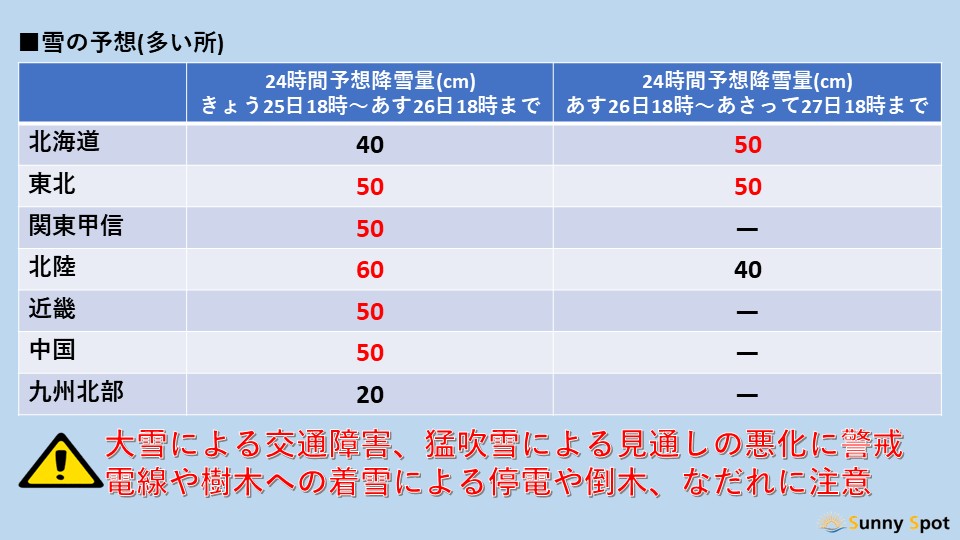
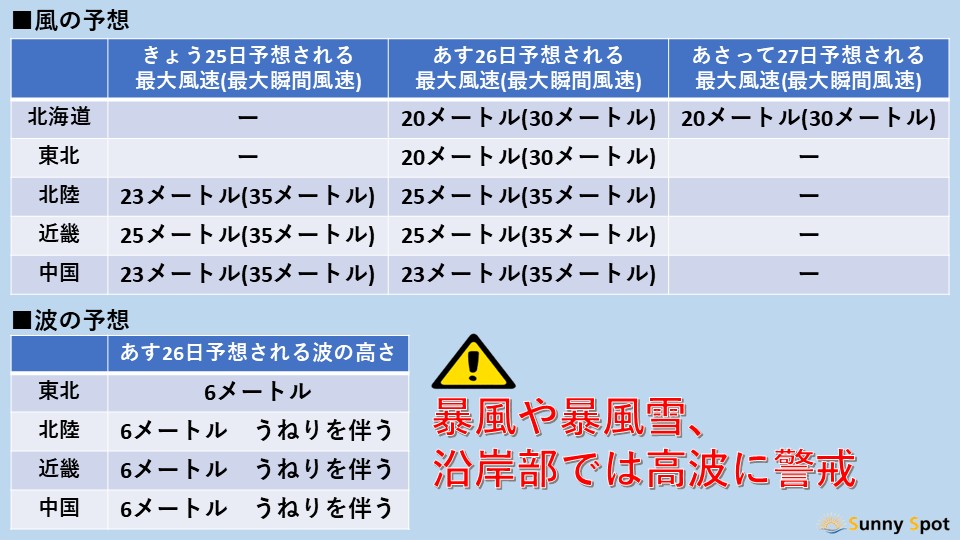
-
[10-day forecast for the year-end and New Year holidays] Will stormy weather coincide with the rush to return home and make U-turns Possibility of snow on the Pacific side early in the new year
2025/12/25 14:52

-
# Weather points for 10 days during the year-end and New Year holidays #
+Tonight to Friday the 26th, warning-level heavy snow and strong winds mainly on the Sea of Japan side
+From the end of the year to New Year's Day: Calm weather with high temperatures
+January 2nd (Friday) Low pressure on the south coast, snow in places on the Pacific side
+3rd (Saturday) A low pressure system is rapidly developing and there is a risk of stormy weather
+There is a possibility that the U-turn rush will overlap with the stormy weather
I think that many people will finish work today, the 25th (Friday), and go on their year-end and New Year holidays from tomorrow the 26th (Saturday) to January 4th (Sunday).
Let's take a look at the detailed weather for the next 10 days.
#Tomorrow, the 26th (Friday)#
The winter-like pressure pattern will strengthen, and quite strong cold air will flow into the upper atmosphere in a westerly direction.
Snow clouds are moving not only on the Sea of Japan side but also on the Pacific side,
There are places where it will snow in Hiroshima, Kyoto, Mie, and Iwate prefectures, and snow is expected to accumulate on Mt.
.
From 6 a.m. on Friday the 26th to 6 a.m. on Saturday the 27th, 70 centimeters of snow is expected to fall in many mountainous areas in Tohoku, Hokuriku, and the Tokai region.
Please be careful of traffic disruptions due to heavy snow.
In addition, due to the rapidly developing low pressure system, very strong winds are expected to be accompanied by snow,
which is expected to cause snowstorms in some places.
Please be careful of strong winds that could overturn the truck and poor visibility due to blizzards.
During this year, there is a possibility that the weather will be particularly bad on Friday the 26th,
transportation may be affected, so if you are planning to return home tomorrow, please be aware of the latest traffic information.
#27th (Sat) - 28th (Sun)#
Many places around Honshu will be covered by a mobile high pressure system, resulting in mild winter skies.
The temperature is expected to be high and it will not be very cold.
It might be a good idea to do your year-end shopping on Saturdays and Sundays.
#29th (Monday) - 31st (Wednesday) New Year's Eve#
Low pressure systems are expected to pass one after another near Hokkaido.
Although there will be snow and rain in many places in northern Japan,
the low pressure system itself will not develop that much, and the area that will experience rough weather is expected to be narrow.
It is expected that there will be very little snow or rain during the time when the New Year's Eve bell rings.
Also, due to the influence of warm air heading toward a low pressure system, temperatures will be higher,
The end of the year is not expected to be as bitterly cold as in previous years.
#January 1st (holiday), New Year's Day#
The current forecast is that New Year's Day 2026 will be gently covered by high pressure, and many places will be relatively sunny.
The first sunrise of the year is likely to be seen in many places, mainly in western and eastern Japan.
(Forecast as of December 25th)
#January 2nd (Friday) - 3rd (Saturday)#
Although there are many places where the weather is relatively calm at the end of the year, stormy weather is expected early in the new year.
On the 2nd (Friday), due to the influence of a low pressure system moving eastward off the southern coast of Honshu,
snow and rain are expected to fall on the Pacific side, where it usually doesn't snow.
Depending on the development of the low pressure system and the strength of the cold air above, there is a possibility of heavy snow that may affect traffic, such as
U turn rush.
In addition, on the 3rd (Saturday), the low pressure system is expected to rapidly develop
and move towards the waters near the Chishima Islands,
with the possibility of heavy snow and strong winds in northern and eastern Japan, resulting in stormy weather.
If the low pressure system develops as predicted,
planes, expressways, trains, etc. may be delayed or canceled around the 2nd (Friday) to 3rd (Saturday) of the new year.
Please continue to pay attention to the latest weather and traffic information.







